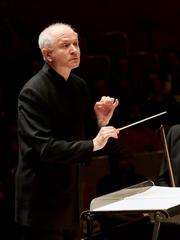|
Back
Starry performance from Barbara Hannigan Toronto
Roy Thomson Hall
03/04/2015 -
Chris Paul Harmon: Lieder und Arien
George Benjamin: Duet for Piano and Orchestra
Hans Abrahamsen: let me tell you (*)
Barbara Hannigan (soprano), Ryan MacEvoy McCullough (piano)
The Toronto Symphony Orchestra, George Benjamin, Peter Oundjian (*) (conductors)

G. Benjamin (© Malcolm Cook)
The second of the TSO’s New Creations Festival began with a new commission by Chris Paul Harman, Lieder und Arien. The title translates as “Songs and Arias” but there is no singing as the title is that of a collection of chorale melodies by J. S. Bach. Harmon has taken several of the melodies and created a “quasi-continuous” (his descriptor) single-movement work. It begins with a plaintive, lonesome piano part quickly joined by the celeste and echoing chimes. Bachian cadences are recognizable as the pinging sections tumble along with slashing interruptions that seem to come from a distance. It has a slow, dreamlike ending, with conductor George Benjamin (the work’s dedicatee) holding a long silence at the finish. More a soundscape than a piece with development.
George Benjamin then conducted the Canadian premiere of his Duet for Piano and Orchestra which dates from 2008. The 12-minute work matches up sonorities from various parts of the piano’s range with compatible instrumental groups in the orchestra, such as the double basses with the lower reaches of the keyboard and brass with the treble range. The orchestra has no violins and has an unusual set-up on the platform. It is definitely not a piano concerto nor exactly piano versus orchestra. Deliberate cross-purposes perhaps? Pianist Ryen MacEvoy McCullough seems to be trying to articulate something, then “stammers” and halts before another try is made. It ends abruptly.
The final work was let me tell you by Danish composer Hans Abrahamsen. The text is by Paul Griffiths from his novel of the same name which is written using only the vocabulary used by Ophelia in Hamlet in which her role uses a total of only 481 words. Nowhere in the musical piece, though, does she utter any of Ophelia’s phrases. The work is in three parts, the first one starting with “Let me tell you how it was”; the second part with “Let me tell you how it is”; and the third part with “I know you are there”. The text seems to lead the reader/listener to some sort of concluding point but it remains persistently out of reach.
Like the Harman work it starts out plaintively, this time with high wind instruments. The singer is given long lines with some stratospheric high notes; there are a lot of gossamer effects. Part II requires more orchestral muscle plus some coloratura from the singer. Part III has a slow, rather stately progress toward an eventual fading-into-nothingness ending. Parts of it brings back memories of Henryk Gorecki’s Symphony of Sorrowful Songs.
The 30-minute work was premiered by the Berlin Philharmonic Orchestra under Andris Nelsons in December 2013, with Barbara Hannigan performing. She displays an amazing facility for the work despite its daunting subtleties, which she sings without a score. It is one of the more than 80 world premieres she has performed and this performance demonstrated why she is currently the muse for so many composers exploring a widening range of tonality.
Michael Johnson
|